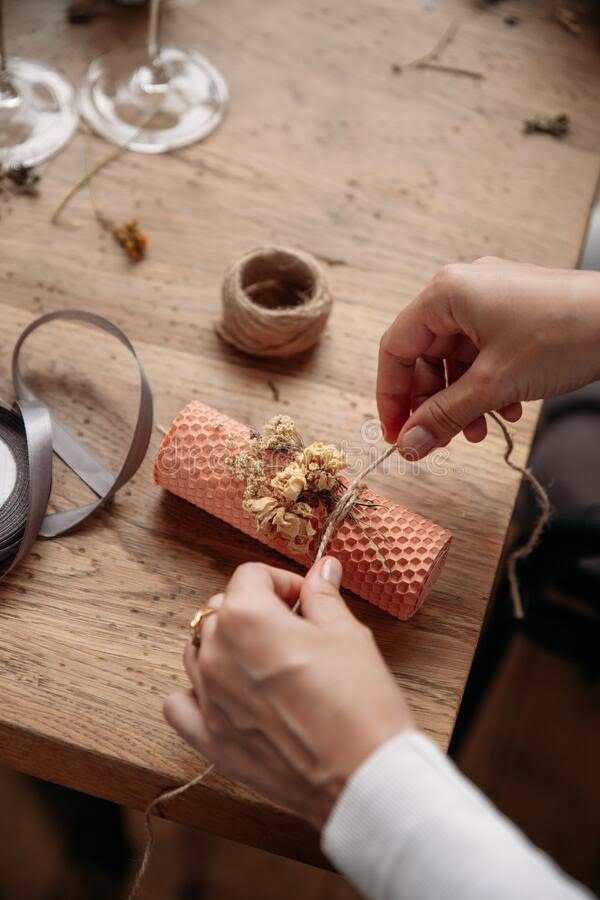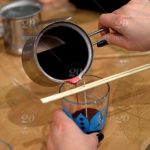When it comes to making candles, one of the most common issues that candlemakers face is candle tunneling. This phenomenon occurs when the wax in a candle burns unevenly, leaving a narrow tunnel down the center and wasted wax along the sides. However, with the right knowledge and techniques, it is possible to prevent candle tunneling and create beautifully burned candles.
In this article, we will delve into the concept of candle tunneling and explore why it happens in the first place. Understanding these factors is crucial in finding effective solutions to prevent this issue from occurring in our homemade candles. We will also explore common causes of candle tunneling, such as improper wick size and placement, as well as how choosing the right wax and fragrance load can play a role.
Furthermore, we will discover that container size and shape are also important considerations when it comes to avoiding candle tunneling. By understanding how each of these factors contributes to uneven burning, we can take proactive steps towards preventing this issue and enjoying perfectly burned candles every time.
So whether you are a seasoned candlemaker or just starting out on your DIY journey, join us as we take a deep dive into preventing candle tunneling. With our step-by-step guide and additional tips and tricks for avoiding tunneling, you’ll be well-equipped to troubleshoot any issues that may arise. Say goodbye to wasted wax and hello to candles that burn evenly from start to finish.
What is Candle Tunneling and Why Does it Happen?
Candle tunneling is a common issue that many candle makers face. It refers to the phenomenon where a candle burns straight down the center, leaving a hard ring of wax around the outside of the jar. This creates an inefficient burn and wastes a significant amount of wax. To prevent tunneling, it is crucial to understand why it happens in the first place.
Tunneling occurs when the candle’s wick does not generate enough heat to melt the entire surface of the wax pool. Instead, it only melts a small area around itself, creating a tunnel-like effect. There are several factors that contribute to this problem.
One major cause of tunneling is using wicks that are too small for the diameter of the container. A wick with insufficient heat output can lead to incomplete melting and eventual tunneling. On the other hand, a wick that is too large may generate an excessive amount of heat, causing tall flames and uneven burning.
Another factor that contributes to candle tunneling is using an inappropriate ratio of fragrance oil or dye to wax. These additives increase the viscosity of the wax, making it more difficult for it to melt evenly. Using too much fragrance oil or dye can create more resistance for the wick’s heat and result in tunneling.
Additionally, some wax types are more prone to tunneling than others. Dense or hard waxes tend to have poor heat conductivity and may require higher temperatures to fully melt. This can contribute to creating tunnels if not paired with an appropriate wick size.
Overall, understanding why candle tunneling happens allows candle makers to take preventive measures during their crafting process. By choosing suitable wicks, finding the right balance between additives and wax, and selecting appropriate materials, they can effectively minimize or eliminate tunneling in their candles.
Common Causes of Candle Tunneling
When it comes to preventing candle tunneling, it is crucial to understand the common causes behind this issue. By addressing these factors, you can take proactive steps to avoid tunneling and ensure that your candles burn evenly and efficiently.
One of the primary causes of candle tunneling is using a wick that is too small for the diameter of the container. When the wick is too small, it will not create a wide enough melt pool, resulting in tunneling. It is essential to choose a wick size that matches the diameter of your container to promote an even burn.
Another factor that can contribute to candle tunneling is choosing the wrong wax for your candle-making project. Certain types of wax are more prone to tunneling than others. For example, soy wax tends to have better burn characteristics and resist tunneling compared to paraffin wax. Additionally, using a fragrance load that is too high can also cause tunneling as it can impact the performance of the wax.
The environment in which you burn your candles can also play a role in causing tunneling. Drafty locations or areas with uneven heat distribution can lead to uneven burning and tunneling issues. It is important to place your candles on a stable surface away from drafts or air vents to ensure an even burn.
To prevent candle tunneling, consider these factors when making your candles:
- Choose the right wick size based on the diameter of your container.
- Use a wax type that has good burn characteristics and resistance against tunneling.
- Avoid overloading your candles with excessive fragrance.
- Place your candles in a draft-free location for optimal burning conditions.
By taking these factors into consideration during the candle-making process, you can significantly reduce or eliminate the occurrence of candle tunneling, resulting in beautifully burned candles with an even melt pool.
The Importance of Proper Wick Size and Placement
The success of preventing candle tunneling greatly depends on the proper wick size and placement. To understand why this is crucial, it is important to first grasp how the wick works in a candle. The wick acts as the pathway for the melted wax to travel up to the flame, creating a steady burn.
When it comes to wick size, it is essential to choose a wick that matches the diameter of your candle. If the wick is too small, it will not generate enough heat to melt the wax evenly across the entire diameter of the container. This can result in tunneling since only a small portion of the wax around the wick will be burned, leaving untouched wax around the edges.
On the other hand, if you select a wick that is too large for your candle’s diameter, it will create an excessive amount of heat and melt too much wax at one time. This could lead to an oversized flame and uneven burning, eventually causing tunnelling as well.
In addition to selecting the right wick size, proper placement is equally important in avoiding candle tunneling. The placement refers to where you position the wick within your container before pouring in the wax.
Make sure that your wick is centered and straight so that it burns evenly throughout all parts of your candle. When a wick is off-center or tilted towards one side, only a portion of the wax around that area will be consumed while leaving other areas untouched – thus promoting tunneling.
By paying close attention to selecting an appropriate-sized wick and ensuring its proper placement within your candles, you can significantly reduce or even eliminate instances of tunneling. Properly-sized and placed wicks guarantee that heat distributes evenly across their containers allowing for complete melting and utilization of all wax present.
Choosing the Right Wax and Fragrance Load to Prevent Tunneling
Wax selection plays a crucial role in preventing candle tunneling. Different types of wax have different melting points and burn rates, which can affect how evenly the candle burns. To prevent tunneling, it is important to choose a wax that has a low melting point and a slow burn rate.
Soy wax is often recommended for its ability to burn evenly and prevent tunneling. It has a lower melting point compared to other waxes, which means that it will melt more evenly and prevent the formation of a tunnel. Soy wax also has a slower burn rate, allowing for a longer burning time and reducing the likelihood of tunneling.
When choosing a fragrance load for your candle, it is important to consider its impact on the wax’s performance. Fragrance oils with high flashpoints are recommended as they are less likely to affect the performance of the wax. High flashpoint fragrance oils release scent gradually during the burning process, promoting even melting and reducing the risk of tunneling.
It is also important to consider the concentration or percentage of fragrance oil used in the candle making process. Too much fragrance oil can cause the wax to become too soft, leading to uneven burning and potential tunneling. On the other hand, using too little fragrance oil may result in an unsatisfactory scent throw. Finding the right balance between fragrance concentration and wax performance is essential in preventing tunneling while still achieving desired scent strength.
| Wax Type | Melting Point | Burn Rate |
|---|---|---|
| Soy Wax | 120-180°F (49-82°C) | Slower burn rate than paraffin |
| Paraffin Wax | 120-160°F (49-71°C) | Fast burn rate |
| Beeswax | 145-149°F (62-65°C) | Slowest burn rate |
The Role of Container Size and Shape in Avoiding Candle Tunneling
When it comes to preventing candle tunneling, the size and shape of the container play a significant role. Choosing the right container can help create an even burn and prevent the formation of a tunnel in your candles.
One important factor to consider is the diameter of the container. A wider diameter allows for a larger pool of melted wax, which helps ensure that the flame reaches the edges of the container. This prevents tunneling by allowing all of the wax to be used evenly, rather than just melting down in a small tunnel in the center.
Additionally, the height of the container is also crucial. The taller the container, the longer it will take for the heat to reach the edges and melt all of the surrounding wax. This can lead to uneven burning and tunneling. It is recommended to choose containers with shorter heights to promote an even burn throughout.
Furthermore, considering the shape of your container can also contribute to preventing candle tunneling. Containers with straight sides are often preferred over those with curved or tapered sides, as they allow for a larger melt pool and better heat distribution.
By selecting containers with an appropriate diameter and height, as well as opting for those with straight sides, you can greatly reduce the chances of experiencing candle tunneling in your homemade candles. Experimentation may be necessary to find what works best for specific waxes, fragrances, and wick sizes, but taking into account these factors will help you achieve beautifully burned candles without any unwanted tunnels.
| Container Feature | Effect on Tunneling |
|---|---|
| Wider Diameter | Allows for larger melt pool and even burn |
| Shorter Height | Prevents heat from taking too long to reach edges |
| Straight Sides | Promotes better heat distribution and larger melt pool |
Step-by-Step Guide
Step 1: Selecting the Right Wick
To prevent candle tunneling, selecting the right wick is crucial. The size and type of wick you choose will greatly affect how your candle burns. It’s important to match the appropriate wick diameter to the diameter of your container.
If the wick is too small, it won’t burn hot enough to melt all the wax around it, causing tunneling. On the other hand, if the wick is too large for your container, it will create an excessive flame that can lead to uneven burning. Consulting a wick sizing chart or seeking advice from experienced candle makers can help ensure you choose the correct wick for your candles.
Step 2: Preheating Your Container
One effective way to prevent candle tunneling is by preheating your container before pouring in the wax. This method helps reduce temperature variations between the center and sides of the candle as it cools down. To preheat your container, place it in a warm oven at a low temperature for about 10-15 minutes. Warming up the container enables the wax to adhere well to its sides, leading to a more even burn and preventing tunneling.
Step 3: Ensuring Proper Wax Cooling Time
Allowing sufficient cooling time after pouring your wax is another important step in preventing candle tunneling. Generally, you should let your candles cool at room temperature for at least 24 hours before lighting them.
Rushing this process increases the risk of tunneling as unmelted wax remains along the edges while being consumed deep into a hole in subsequent burns. By patiently allowing enough cooling time, you allow all areas of the wax pool to melt during each burn, reducing chances of tunnel formation.
Step 4: Regularly Trimming Your Wick
Regularly trimming your wick is another effective practice to avoid candle tunneling. Before each burn, trim the wick to about 1/4 inch or as specified by the wick manufacturer. Trimming the wick helps control the size of the flame and prevents excessive heat, which can cause tunneling. Additionally, a well-maintained wick reduces soot buildup and prolongs the life of your candle.
Step 5: Rotating the Candle
Rotating your candles during burns is a simple yet effective technique to prevent tunneling. Candle tunneling often occurs when a consistently small area is burned each time, leaving most of the wax unburned. Gently rotating your candle periodically ensures that all sides are exposed to a sufficient amount of heat and light. This encourages an even burn throughout and helps prevent tunnel formation.
By following these steps, you can greatly reduce or eliminate candle tunneling issues in your homemade candles. It’s important to remember that external factors like drafts and placement can also affect how evenly your candles burn. Ultimately, proper care and attention throughout the candle-making process will result in beautiful candles with an even wax pool and no sign of tunneling.
Additional Tips and Tricks for Avoiding Tunneling
In addition to using the right wick size and proper wax and fragrance load, there are several other tips and tricks you can employ to prevent candle tunneling when making candles. These additional measures will help ensure that your candles burn evenly and smoothly, providing a beautiful ambiance and long-lasting fragrance.
One effective technique is to trim the candle wick regularly. Many people overlook this step, but it plays a crucial role in preventing tunneling. Over time, the wick can become too long, causing a larger flame and an uneven burn. By trimming the wick to about ¼ inch before each use, you ensure that it burns steadily and evenly, preventing tunneling from occurring.
Another important tip is to avoid drafts while burning candles. Air movement can disrupt the even melt pool of wax around the wick and lead to tunneling. To prevent this, keep windows closed or avoid placing your candle near open doors where a breeze may pass through. This will help maintain a consistent heat distribution throughout the candle’s surface area, minimizing tunneling.
Furthermore, it is essential to allow your candle enough burning time during each use. When lighting your candles, make sure to let them burn long enough for the entire top layer of wax to melt completely before extinguishing. This process helps create an even melt pool across the entire surface of the candle, preventing tunneling by eliminating any potential build-up of unused wax along the sides.
By following these additional tips and tricks, you can further safeguard against tunneling when making candles. Trimming the wick regularly, avoiding drafts while burning, and allowing sufficient burning time all contribute to ensuring an even and complete burn. Incorporating these measures into your candle-making routine will not only prevent tunneling but also enhance your overall candle experience with improved fragrance throw and longer burn times.
Troubleshooting
Identifying Candle Tunneling
Before we dive into troubleshooting candle tunneling issues, it’s important to know how to identify this problem. Candle tunneling occurs when the wax burns down in a tunnel-like manner, leaving wax built up along the sides of the container and often resulting in an uneven burn. This can lead to wasted wax and a shorter burn time for your candles.
To determine if your candle is experiencing tunneling, simply examine the melted wax pool after burning for a few hours. If there is a noticeable ring of unburned wax around the wick or if the sides of the container remain untouched, then you are dealing with candle tunneling.
Addressing Wick Size and Placement
One common cause of candle tunneling is using wicks that are too small or placing them incorrectly in the container. An undersized wick may not generate enough heat to melt the entire surface area of the wax, resulting in tunneling. To avoid this issue, it’s crucial to select the right wick size based on the diameter of your container and the type of wax you are using.
Additionally, proper placement of the wick can help prevent sidewall build-up and promote even burning. Make sure that the wick is centered and straight before pouring in the wax.
Adjusting Burn Time and Trimming The Wick
To fix candle tunneling issues during burning, there are a couple of adjustments you can make. Firstly, try increasing your burn time during each lighting session. A longer burn time will allow for more surface area of wax to melt, preventing tunneling as you reach deeper layers.
Secondly, trimming your wick before each use can also help avoid uneven burning patterns. Trimming the wick to about ¼ inch will regulate flame height and ensure optimal melting across all parts of the candle. By following these simple troubleshooting steps, you can correct candle tunneling problems and enjoy a more efficient burn.
Conclusion
In conclusion, preventing candle tunneling is essential in order to enjoy perfectly burned candles. By understanding the concept of candle tunneling and its causes, you can take proactive steps to prevent it from happening. Factors such as proper wick size and placement, choosing the right wax and fragrance load, and container size and shape all play a crucial role in avoiding tunneling.
One of the key factors in preventing candle tunneling is selecting the appropriate wick size and placing it correctly. A wick that is too small may not burn hot enough to melt the entire surface of the wax, resulting in tunneling.
On the other hand, a wick that is too large can cause an excessive flame that leads to an uneven burn. It’s important to follow guidelines or consult with experts to determine the right wick size for your specific candle.
Additionally, choosing the right wax and fragrance load is crucial for preventing tunneling. Some types of wax have a higher melting point than others, which can influence how evenly the candle burns. Furthermore, adding too much fragrance oil can impact the burning process and increase the likelihood of tunneling. Finding the optimal balance between wax type and fragrance load will contribute to a more even burn and help prevent tunneling.
Lastly, container size and shape should be considered when making candles. A wider container allows for more heat dispersal, reducing the risk of tunneling. The shape of the container also affects airflow around the candle, which can impact how evenly it burns. Experiment with different container sizes and shapes to find what works best for your candles.
By following these guidelines and troubleshooting tips outlined in this article, you’ll be able to create beautifully burned candles without any instances of tunneling. Enjoy your candle-making journey while delighting in perfectly lit candles that create a warm ambiance in any space.

Welcome to my candle making blog! In this blog, I will be sharing my tips and tricks for making candles. I will also be sharing some of my favorite recipes.





